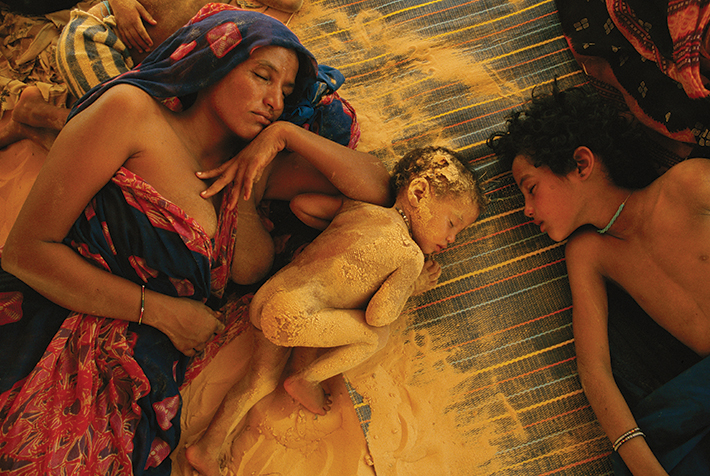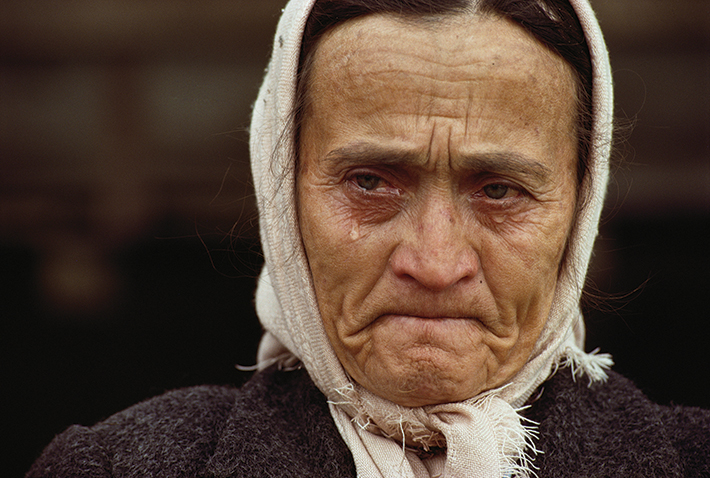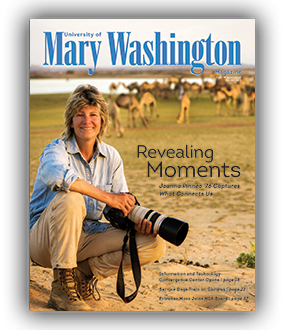
MALI Members of the Taureg tribe live far outside of Timbuktu, Mali. Pinneo was on assignment there to visit and photograph the Taureg, and they invited her to join them in the family tent to nap and take refuge from the desert sun. Pinneo woke and shot a roll of film before falling back to sleep in the heat. National Geographic included this image in its 50 Greatest Pictures compilation, used it on the cover of its May 1998 magazine on global climate change, and printed it again on the cover of its book Women Photographers at National Geographic.
For hundreds of years the Taureg depended on a West African lake system that in the last 25 years has mostly dried up, Pinneo said. “The life that these people have led for centuries is changing.”
(All Photos by Joanna Pinneo ’76)
Joanna Pinneo ’76 loved the month she spent in Spain her sophomore year, immersing herself in Spanish culture and studying the works of the masters at Madrid’s Prado museum.
She wasn’t nearly as crazy, however, about the images she captured with her point-and-shoot camera, especially after seeing the photographs her boyfriend took with his own more-expensive device. So Pinneo, who majored in art history and psychology, returned to campus, wrote an A paper on Diego Velazquez’s 17th-century masterpieces, and bought herself a new camera.
“When I found the camera, it was like a light bulb went off. I found ‘the thing,’ ” Pinneo recalled. “I was really kind of hooked from then on.”
For the shy young woman from Richmond, the camera was a passport of sorts, giving her the confidence to engage with strangers – ultimately in more than 65 countries. During Pinneo’s career as a photojournalist, her intimate and moving images have appeared in National Geographic, Life, Time, The New York Times Magazine, U.S. News & World Report, Mother Jones, GEO,and Stern, among other publications.
She’s documented lush tea plantations in Indonesia and the smoldering remains of logged rainforests in Brazil. She’s covered the impact of climate change on tribes in the sub-Saharan region of West Africa and melting glaciers in Europe. She’s photographed El Niño-related flooding in Peruvian villages and spent 2½ months trekking across the desert region of Sudan – some of that on camel back.
Each assignment is markedly different, but the goal is often the same, Pinneo said: to promote understanding between people and among cultures.
“Photography really has been a miraculous thing for me,” she said, “to open up the world and bring those kinds of connections to people. I really love photographing people in their daily lives. I just try to see what emerges.”
Guided by art history lessons on light, mood, color, and composition, Pinneo got her start taking pictures for UMW’s student-run newspaper, then named The Bullet, as well as for the Battlefield yearbook. She took the one photography class offered at Mary Washington in those days. After graduation she attended a four-month photo workshop in West Virginia, where she picked up the technical skills she’d need for the career of her dreams. Then, she set about job-hunting.
“When you get to know Joanna, she’s so gracious and sincere, and I think that sincerity comes across to people in other cultures. She’s got an ability to just disappear and just quietly be with people and find those moments of humanity.” – Annie Griffiths, photographer
“Basically, I put the word out there that I wanted to travel and take pictures,” Pinneo said. “The job immediately became much deeper than that.”
After a brief stint running a community darkroom in Richmond, Pinneo landed a job in the photo lab of the International Mission Board, a mission-support entity of the Southern Baptist Convention. There, she processed film, made duplicate slides, and carefully studied the images captured by the organization’s talented staff for its award-winning Commission Stories magazine. Within a few years, Pinneo herself was documenting the work of missionaries around the world.
One of her pictures, of an injured child reaching out to an aid worker in the wake of a devastating volcanic mudslide in Colombia in 1985, was nominated for a Pulitzer Prize. More importantly, the child was reunited with his mother after the picture appeared on a Colombian TV station.






In 1991, with Operation Desert Storm underway, Pinneo traveled to the Middle East at the request of National Geographic. She spent eight months documenting the lives of Palestinian refugees throughout the region, as well as in London and the U.S. Seeing her work for the first time in one of the world’s preeminent photo magazines was pretty special, she said.
“I remember feeling like if I was never able to do it again, at least I did it once,” said Pinneo, who would ultimately complete eight assignments for the magazine on everything from immigration to climate change.
Pinneo’s ability to capture beautiful images while also telling important conservation stories has made her a favorite among editors at Ranger Rick, a National Wildlife Federation magazine for children. Ranger Rick has sent her hiking across Washington State, sailing off the coast of Maine, and snowshoeing in Minnesota, among other adventures. She makes the youngsters she photographs so comfortable that they almost forget she’s there, said photo editor Susan McElhinney, who has known Pinneo for nearly 30 years.
“She has such a wonderful touch with people,” McElhinney said. “There’s a certain gentleness in her images, a genuineness in them. She conveys these stories beautifully.”
Traveling the globe with camera in hand is not without its risks. While covering the effects of El Niño and La Niña on the people of Peru, Pinneo ended up in the hospital with a punctured lung after the car she was riding in was sideswiped by a taxi and flipped. Toward the end of a 40-day trek across Sudan’s Sahara Desert, Pinneo was bitten or stung on the hand, possibly by a scorpion. For four days it was unclear what was moving faster − the Land Cruiser she shared with herders, a driver, diesel fuel, and water, or the red line of infection that snaked up her arm.
It took three days in a Khartoum hospital bed and a hefty dose of antibiotics to set her right again. But Pinneo shrugs off incidents like that, preferring instead to focus on the difference her work can make, whether it’s encouraging young readers of Ranger Rick to embrace the fragile bayous of southern Louisiana or inspiring donors in the West to support a shelter where women and girls in a Bangladesh slum can receive meals, medical care, skills training, and education.
She photographed the story in Bangladesh last year for the International Mission Board, her first assignment for the organization in about 20 years. Within months of the story’s May publication, the 9-year-old girl Pinneo had focused on had gone from begging in the streets with her mother to support the family to attending classes five days a week.

BOSNIA This Serbian woman left three daughters behind when she fled to Bosnia as her village was shelled. When she was 12, all of her family had died in a World War II Croatian work camp. Pinneo met her while she was on a National Geographic assignment on European immigration. “She felt it was all returning again,” Pinneo said.
“I really want to be an advocate. I really feel like storytelling is important – wanting to understand other people and other cultures and then show people what other people’s cultures and lives are like so they have a greater understanding,” Pinneo said. “I’m not trying to build my career in the same ways I was 30 years ago. I’m just trying to find my strengths, what I do well, and how I can help.”
That desire led Pinneo to found Grrlstories, a project dedicated to giving young girls a voice through photography. She also recently joined Ripple Effect Images, a nonprofit team of photojournalists who document the plight of impoverished women and girls around the globe and then donate their images to organizations dedicated to helping them succeed. Over the last four years, Ripple Effect’s team has created 17 films and an archive of about 12,000 images, helping its partners raise more than $1 million in aid, said Annie Griffiths, the group’s founder and executive director and one of the first female photographers to work for National Geographic.
Pinneo was a natural fit for the organization, which focuses largely on the impact of climate change on marginalized populations, Griffiths said.
“When you get to know Joanna, she’s so gracious and sincere, and I think that sincerity comes across to people in other cultures,” said Griffiths, whose friendship with Pinneo goes back decades. “She’s got an ability to just disappear and just quietly be with people and find those moments of humanity.”
In addition to shooting, Pinneo, who lives with her husband outside Boulder, Colorado, said she enjoys teaching workshops that cover not only the mechanics of photography but “how to approach people mindfully.”
“It’s almost a spiritual approach, the idea that we’re all connected and what one person does influences another,” Pinneo said. “Everything has an impact somewhere. I want that to be an impact of kindness, an impact of compassion, an impact of caring. If I can enter someone’s life with those intentions, I hope that carries forward somehow.”
See more of Joanna Pinneo’s photos.

